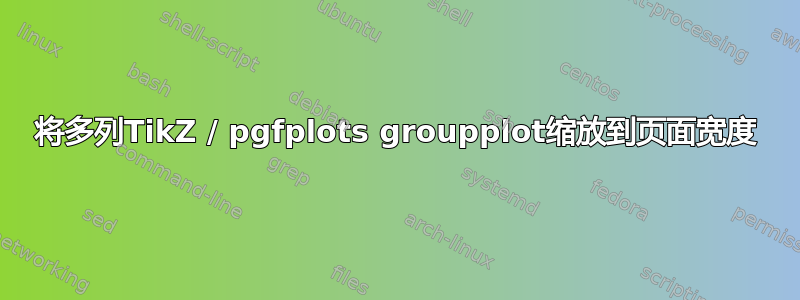
我正在尝试缩放具有多个(和可变数量)子图的 pgfplots groupplot 以匹配\textwidth文档。
width我发现定义中的参数之间似乎没有直接关系groupplot,因此一个简单的公式(例如)1/<n-plots>*(\textwidth-<padding>)在不同的绘图中产生的结果非常不同。此外,我预计函数(例如)1/<n-plots>*\textwidth最坏的情况下会超过页面宽度,因为没有考虑填充,但事实证明结果小于页面宽度,并且随着绘图的增多而趋于缩小,这表明存在某种负填充。
如何计算的宽度groupplot,以及如何将其缩放到固定宽度而不管列数是多少?(我对简单地重新缩放整个图像的解决方案不感兴趣。)
以下为示例图:

\begin{tikzpicture}
\begin{groupplot}[
group style={
group size=5 by 1,
vertical sep=0pt,
ylabels at=edge left,
xlabels at=edge bottom,
yticklabels at=edge left,
horizontal sep=0pt,
},
extra y ticks={20},
extra y tick style={grid=major},
width=1/5*\textwidth,
height=5cm,
ylabel=coverage,
tickpos=left,
xtick=\empty,
ytick align=inside,
xtick align=inside,
ymin=0,
ymax=110,
xmin=0,
xmax=2
]
\nextgroupplot[xlabel=1]
\addplot [blue!80!black, fill=blue, fill opacity=0.2] coordinates {(0,1)(1,45)(2,34)}
|- (axis cs:0,0) -- cycle;
\nextgroupplot[xlabel=2]
\addplot [blue!80!black, fill=blue, fill opacity=0.2] coordinates {(0,1)(1,45)(2,34)}
|- (axis cs:0,0) -- cycle;
\nextgroupplot[xlabel=3]
\addplot [blue!80!black, fill=blue, fill opacity=0.2] coordinates {(0,1)(1,67)(2,14)}
|- (axis cs:0,0) -- cycle;
\nextgroupplot[xlabel=4]
\addplot [blue!80!black, fill=blue, fill opacity=0.2] coordinates {(0,12)(1,105)(2,34)}
|- (axis cs:0,0) -- cycle;
\nextgroupplot[xlabel=5]
\addplot [blue!80!black, fill=blue, fill opacity=0.2] coordinates {(0,1)(1,45)(2,34)}
|- (axis cs:0,0) -- cycle;
\end{groupplot}
\end{tikzpicture}
答案1
默认情况下,如果您使用width=<length>,PGFPlots 在设置长度时会对标签占用的大小做出一些相当严格的假设(即使子图没有任何标签)。如果您使用 ,scale only axis, width=1/5*\textwidth然后调整该长度以补偿轴标签,则可以获得更可预测的结果。
但是,如果您确实希望绘图完全占据文本的宽度而无需进行手动调整,则应使用tikzscale包:如果将代码放入tikzpicture单独的文件(可能使用filecontents),然后使用包含它\includegraphics[width=\textwidth]{<filename.tikz>},则宽度将自动调整,以便整体绘图填充文本宽度:

\documentclass{article}
\usepackage{pgfplots}
\usepgfplotslibrary{groupplots}
\pgfplotsset{compat=newest}
\usepackage{tikzscale}
\usepackage{filecontents}
\begin{filecontents}{plot.tikz}
\begin{tikzpicture}
\begin{groupplot}[
group style={
group size=5 by 1,
vertical sep=0pt,
ylabels at=edge left,
xlabels at=edge bottom,
yticklabels at=edge left,
horizontal sep=0pt,
},
extra y ticks={20},
extra y tick style={grid=major},
width=1/5*\textwidth,
height=5cm,
ylabel=coverage,
tickpos=left,
xtick=\empty,
ytick align=inside,
xtick align=inside,
ymin=0,
ymax=110,
xmin=0,
xmax=2
]
\nextgroupplot[xlabel=1]
\addplot [blue!80!black, fill=blue, fill opacity=0.2] coordinates {(0,1)(1,45)(2,34)}
|- (axis cs:0,0) -- cycle;
\nextgroupplot[xlabel=2]
\addplot [blue!80!black, fill=blue, fill opacity=0.2] coordinates {(0,1)(1,45)(2,34)}
|- (axis cs:0,0) -- cycle;
\nextgroupplot[xlabel=3]
\addplot [blue!80!black, fill=blue, fill opacity=0.2] coordinates {(0,1)(1,67)(2,14)}
|- (axis cs:0,0) -- cycle;
\nextgroupplot[xlabel=4]
\addplot [blue!80!black, fill=blue, fill opacity=0.2] coordinates {(0,12)(1,105)(2,34)}
|- (axis cs:0,0) -- cycle;
\nextgroupplot[xlabel=5]
\addplot [blue!80!black, fill=blue, fill opacity=0.2] coordinates {(0,1)(1,45)(2,34)}
|- (axis cs:0,0) -- cycle;
\end{groupplot}
\end{tikzpicture}
\end{filecontents}
\begin{document}
\noindent\includegraphics[width=\textwidth]{plot.tikz}
\noindent\hrulefill
\end{document}


